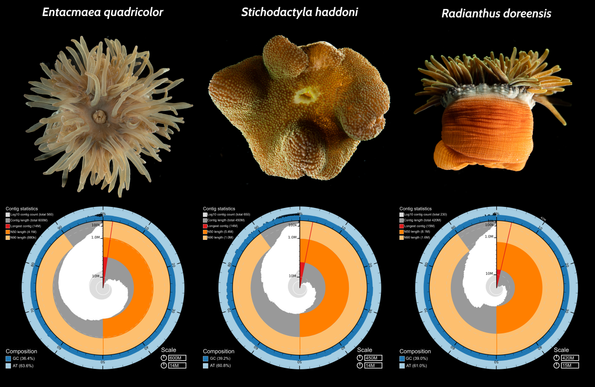De Jode & Titus publish new HiFi assemblies for three clownfish-hosting sea anemones provide important resources to study the evolution of symbiosis from the host perspective
#NewPaperAlert
How do plants from different environments handle temperature extremes? Andrew et al. studied 20 Australian species and found conserved gene expression responses to heat and cold (with biome-specific differences).
Do signaling pathways evolve in a predictable order? Picolo et al. studied 47 pathways across 315 animal species, finding little evidence for a universal link between gene age and pathway position - this suggests stochastic pathway evolution.
Research led by Stephan Baehr shows liquid-phase mutation accumulation experiments can speed up mutation rate studies and better reflect real environments.
New paper by Lewin & Eyre-Walker finds a strong negative correlation between generation time and yearly mutation rate. This highlights generation time as a key driver of molecular evolution across eukaryote clades.
New paper by Howell et al. infers the demographic history of Boston Harbor’s white-footed mice, demonstrating that integrating multiple summaries of genome-wide variation enhances the temporal resolution of population history.
Queen–worker differences are linked to gene duplication and differential gene expression, in particular in reproductive tissues. Study by Xu & Colgan sheds light on how social insects resolve genomic conflict to produce distinct castes.
A large, rare, 225 kb deletion containing six snake venom metalloproteinase genes in eastern diamondback rattlesnake adds to the striking venom diversity shaped by structural variation.
Bacterial operons may persist in eukaryotes (e.g. fungi) after horizontal gene transfer, according to Kogay et al. Operon-derived gene pairs suggest initial neutral retention and later functional integration or degeneration.
Coppage et al. identify four ancient polyploidy events with unusually high duplicate gene retention. Elevated gene conversion and delayed diploidization suggest a distinct class of paleopolyploid genomes.
Comparative transcriptomics of nematodes C. elegans and Brugia malayi supports Ohno’s hypothesis of X-linked genes showing upregulation following Y degeneration, which depends on the dosage-sensitive gene content of proto-X.
New chromosome-level genome assemblies for hexaploid weeds Conyza sumatrensis and C. bonariensis. These resources will serve to inform research into evolution and management of these species.
New study by Chan et al. reveals the evolutionary dynamics of self-splicing introns in mitochondrial genomes of Epichloë fungi. Results support rapid intron loss and evolution of homing suppressors.
New graph-based tool ska lo enables reference-free detection of SNPs, indels, and variant groups from pathogen WGS data. Benchmarking shows high sensitivity, including in regions with dense mutations.
Armstrong et al. estimate de novo germline mutation rates across all extant Panthera species and the Clouded leopard using pedigrees. Reported rates align with other mammals, and can help refine models for phylogenetic and demographic analyses.
How does recurrent drug exposure shape selection in parasites? Early et al. look at French Guiana malaria genomes to show how repeat adaptation is governed by both large-effect loci and a polygenic architecture.
Whole-transcriptome profiling in C. briggsae and C. elegans reveals a post-reproductive shift in gene expression, indicating a dynamic regulation of aging-associated pathways linked to reproduction.
Link: doi.org/10.1093/gbe/...
Surprisingly, those patterns generalize across most rivers (at least in the US), but they're most prominent in the mountains. Formulating a function to capture that ended up being important for the modeling work, and it also turned a "that's funny" side-note into a paper, which I'm thrilled to announce has just been published in JAWRA: https://onlinelibrary.wiley.com/doi/10.1111/1752-1688.13228
(The paper is behind a paywall, but I can share copies on request.)
In the process of developing a new stream temperature model, I noticed some odd seasonal error spikes in mountainous watersheds. It turns out that stream temperature seasonality has some distinct patterns that aren't captured in the typical annual formulation (a sinusoid with a period of one year): in most streams, the spring is colder, summer warmer, autumn colder, and winter warmer than you'd expect from a sine curve.
#NewPaperAlert - More than a "characterizing flavor": Menthol at subliminal levels in tobacco products. Documents show #tobacco cos used 'subliminal #menthol' in nonmenthol cigs to compensate for flavor loss caused by filters & to reduce smoke harshness:
